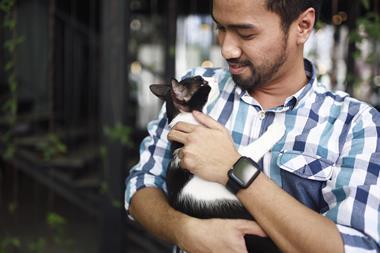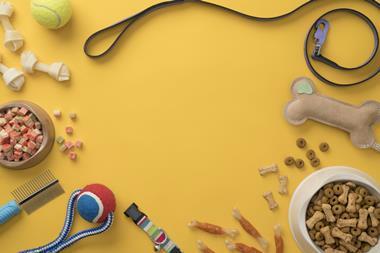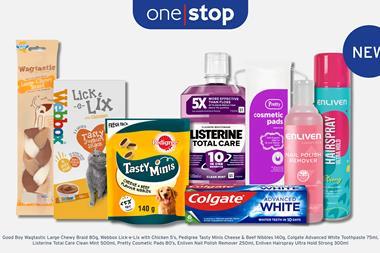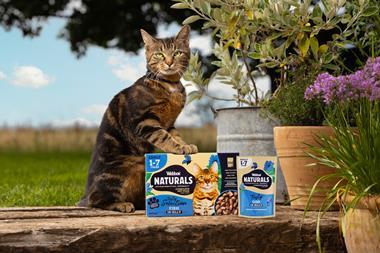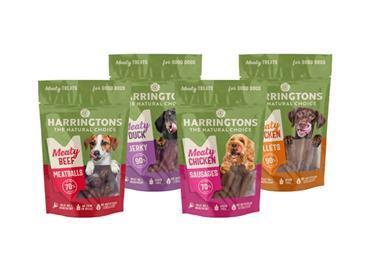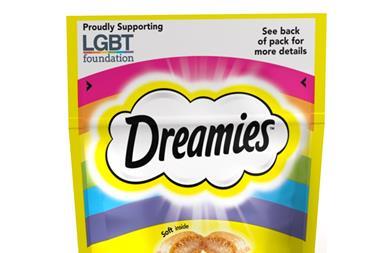The pet care sector is a lucrative one and is growing in value, but it seems retailers are struggling to capture sales. Recent Kantar data shows that pet shoppers are the highest spenders in the convenience sector, spending 22% more than the average customer. However, the same Kantar research reveals that 55% of owners don’t purchase their pet food in their local shops.
48%
That’s the share of UK households which have at least one pet
Source: Pet Food Manufacturers Association 2012
Purina market development organisation director Andrew Harding says that with an abundance of pets in the UK, demand shouldn’t be a problem for retailers if their range is right. “There are more than eight million cats and dogs in the UK - that’s 100 million meals every week,” he points out. “However, pet owners are particular about the food they buy and incredibly loyal to their preferred brand, flavour and format. If a product is unavailable, 73% will leave the store without buying an alternative, potentially taking the rest of their basket spend with them.”
Success all comes down to making sure you are stocking the products that your customers want. With cat and dog food making up 85% of value sales of the pet food and accessories market in 2012 (Mintel, February 2013), that’s what the majority of a convenience store’s display should be made up of.
According to a SymphonyIRI Group InfoScan report, cat food outperformed dog food in 2012, recording a 4.2% value growth compared with the latter’s 2.6% growth. In volume terms, both sub-categories were evenly matched, showing a 0.6% and 0.5% growth respectively.
Within the pet accessories market, cat litter saw the largest growth with a 10.6% increase in value sales, making it a must-stock for retailers keen to grow their pet care sales.
Pets corner
Even though cats and dogs make up the lion’s share of pet food sales, it’s important not to overlook other furry friends. So what are the British public’s animal instincts leaning towards, and are you catering for them in your store?
According to a 2012 survey conducted by the Pet Food Manufacturers Association and TNS, of the 67 million pets in the UK there are eight million dogs and eight million cats. But this pales in comparison to the 20-25 million indoor fish and 20-25 million outdoor fish kept as pets. Rabbits, caged birds and guinea pigs come next on the list, with a million of each of these. Then there are more than 500,000 of both domestic fowl and hamsters.
The lists moves into more exotic territory with newts (100,000), frogs and toads (200,000) and snakes (200,000). There are fewer than 100,000 horse and ponies kept as pets in the UK, although the average c-store may struggle to stock the amount of food needed to keep them going anyway.
There are also 200,000 domestic rats and 100,000 pigeons. And for those who like their pets low maintenance, there are just under 100,000 people keeping insects as pets.
Choosing which format to offer is the next step. In the dog food sector, tins continue to be the most popular packaging format, although change may be on the way as usage fell 2% to 65% in 2012, its lowest in four years.
On the feline side of things, smaller pouches continue to be the most bought format, purchased by 66% of users last year, lifting sales by 8.3% (IRI Total Convenience 52 weeks ending March 2, 2013) with tins in danger being phased out, reaching their lowest point in five years.
Another element to consider is that owners are becoming increasingly focused on pet health, with 45% of all dog owners deeming natural ingredients to be an important choice factor, and six out of 10 owners of cats and dogs believing that pet food with added health benefits is worth paying more for.
In fact, the lengths pet owners will go to in order to pamper their pets is extraordinary. Some 38% of pet owners claim that they would sacrifice their own food before their pets to allow them to maintain a decent diet.
Pet food manufacturers have been reacting to this knowledge, with the ‘no additives/preservatives’ tag being the most used NPD claim in 2012.
151 Products managing director Richard Shonn says that retailers need to capitalise on the focus towards health. “Owners are becoming increasingly conscious about healthy treats with supplements,” he says. “As a result, the most popular choices are those that reflect our own grocery shopping habits - high quality, yet affordable, food and treats that have key ingredients, which provide multiple benefits and help with overall general care.”
Mintel also revealed that the number of new launches into the dog and cat food markets reached a three-year high in 2012, with most of the activity witnessed in the snack and treat area, to cater for the growth in consumers wanting to spoil their pets.
While pampered pooches and cats were often thought of as the domain of the wacky US, Mintel senior food analyst Alex Beckett says there is no doubt the trend has hit our shores.
“Nutrient-rich treats in sophisticated flavours, which amalgamate the buzz areas of functional health, treating and gourmet recipes, stand to have strong appeal,” he says. “And the superior convenience credentials of pouches over tins, and owners’ demand for smaller-sized products, also provide tangible opportunities for pet food manufacturers looking to generate a value growth that is independent of commodity-driven price hikes.”
This sentiment is echoed by Camilla Kimpton of Mars Petcare. “The bond between owners and their pets is a strong one and is reflected in consumer purchasing habits, therefore owners are looking for the very best products on the market for their pets, from brands that they know and trust,” she says.
Retailer’s view
“We extended our pet care section last year to cope with the demand from the many animal owners in the area. We found a lot of them were looking for larger bags of dog food as it represented better value. We asked customers if they would be interested in purchasing larger bags and they were on board with the idea.
“When we increased the floor space of the store last summer we felt it was time to do the section properly as we had the space. We’ve since added an extensive range of cat and dog treats as customers are likely to buy them on top of their usual pet food purchases.
“As well as the big bags of dog food, we’ve introduced a value range of wet cat food in pouches and small tin formats as more customers with cats want the wet food type.
“Customers around this area seem to be big pet lovers. It still amazes me how many 20kg bags of bird seed we sell a week.”
Andrew Jones, Morton Post Office and Stores, Lincolnshire
Given the number of formats, styles and treats out there on the market, retailers would be forgiven for being reluctant to move away from the old favourites. But there are simple merchandising changes you can make to include the newer players.
To start, Kimpton advises keeping treats separate from the main display to capitalise on impulse purchases. “With space at a premium, placing treats at the till point can unlock greater basket spend and encourage last-minute purchase decisions without taking up space in store,” she says. “The care and treats category is an impulsive one and secondary sites such as clip-strips play a vital role in delivering sales uplift.”
Shonn also urges retailers to stock treat items that can be bought on impulse. “We believe dog owners are more inclined to purchase extra treat items for their pets, especially when training their animal,” he says. “With this in mind, retailers should tap into the profitable market and bolster their dog treat offering. I would advise convenience stores to stock up on a range of low-cost, high quality products that are easily accessible to the mass market.”
Kimpton also recommends retailers make sure that customers are aware that they actually stock pet food. “Many people don’t know convenience stores sell pet food, so be sure to use POS and signage to make shoppers aware that your range caters to pet owners,” she states.
Harding agrees with this practice. “Hanging signs and back boards to show shoppers where the pet food section is will make them aware of the range,” he says. “Also, brand block within segments such as complete dry food and single serve cat food to create standout and make the fixture easy to navigate.”
Shonn says that retailers should consider more of a brand approach. “In order to build up loyalty, it is important that retailers stock a healthy supply of different products under one range,” he explains. “If their pet likes a particular treat, then consumers are more likely to buy other pet-related products, such as toys, blankets, food accessories, bowls and grooming products, because they immediately recognise it as a favoured brand.
“The psychology of shopping is no different, whether customers are buying for themselves or their pet,” he reveals.
Ones to watch
Clean up
To give shoppers looking to keep control of their weekly spending a helping hand, Landmark Wholesale has created Lifestyle Value Cat Litter. The 8ltr pack has a pricemark of £2 and is designed to offer an economical alternative to named brands on the market.
tel: 01908 255 300
Get fresh
Feline friends get a fresh meal every time with Mars Petcare’s Sheba Fresh Choice, with each 50g pouch equating to one meal.
Available in fish, poultry and meaty variants, the range comes in packs of six pouches (rrp £1.99). The mini pouches will be supported by a £4.6m campaign.
tel: 01664 411 111
Breathe easy
Four out of five dogs over the age of three have gum disease, so keeping teeth in order is a must for dog owners. Containing green tea and eualyptus oil, DentaStix Fresh are designed to do the job. They are available in seven-stick (rrp £1.89) and 28-stick (rrp £7.29) pack sizes.
tel: 01664 411 111
Munch bunch
Owners are also becoming increasingly conscious about the meat content of the food they give their pooches. Enter 151 Products’ Serrano Ham treats, new to its Munch & Crunch range. The treats come in Serrano Ham with chicken, beef, turkey and cheese variants.
rrp: £1
tel: 0161 839 5949
Go time
Purina has introduced a new complete dry cat food range. Available in salmon, tuna & added vegetables, and beef, chicken & added vegetables, Go-Cat Crunchy & Tender comes in 375g and 800g pack sizes. The range will be supported by a £3.9m media campaign including a TV ad, digital and in-store support.
tel: 0800 141 2343
Source
Aidan Fortune
















